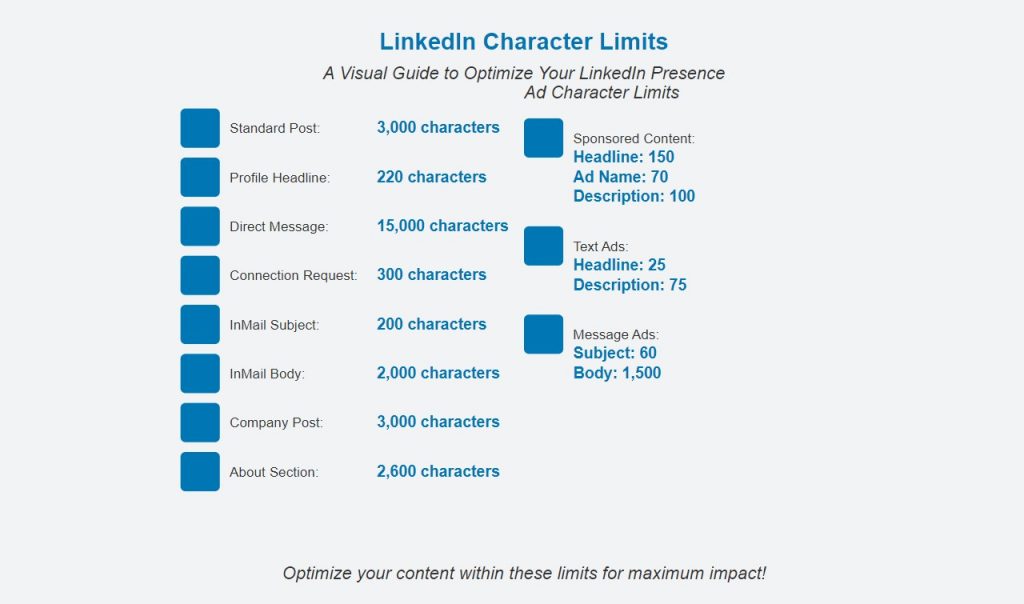Our Linkedin character counter tool helps users track the characters limit used in their posts, profiles, and messages on the platform.
Imagine you’re crafting a post about a recent project. As you type, the character counter displays “250/1300”. This means you’ve used 250 characters out of the 1300 available, allowing you to gauge how much space remains for your message.
LinkedIn Character Counter
| Character Limit | |
|---|---|
| Standard Post | 3,000 |
| Post Visibility in Feed (without “see more”) | 210-230 |
| Profile Headline | 220 |
| Direct Message | 15,000 |
| Sponsored Content Ad Headline | 150 |
| Sponsored Content Ad Name | 70 |
| Sponsored Content Ad Description | 100 |
| Text Ad Headline | 25 |
| Text Ad Description | 75 |
| Message Ad Subject Line | 60 |
| Message Ad Body | 1,500 |
| Connection Request Message | 300 |
| InMail Subject Line | 200 |
| InMail Body | 2,000 |
| Company Post | 3,000 |
| Profile “About” Section | 2,600 |

LinkedIn Post Character Limit
For standard posts, LinkedIn allows up to 3,000 characters. This generous allowance provides ample space for sharing detailed insights, experiences, or professional updates. Itt’s worth noting that only the first 210-230 characters (about 2-3 lines) appear in the feed without users clicking “see more”.
To maximize engagement:
- Front-load key information
- Use compelling opening lines
- Incorporate line breaks for readability
LinkedIn Headline Character Limit
Your LinkedIn headline, the text directly below your name, is limited to 220 characters. This concise space is crucial for making a strong first impression. Craft a headline that:
- Summarizes your professional identity
- Includes relevant keywords
- Highlights your unique value proposition
Example: “Digital Marketing Strategist | Driving Growth Through Data-Driven Campaigns | Forbes 30 Under 30”
LinkedIn Message Character Limit
When sending direct messages to connections, you have up to 15,000 characters at your disposal. This limit allows for detailed communications, but remember that brevity often leads to better engagement. Structure longer messages with:
- Clear subject lines
- Bulleted or numbered lists
- Concise paragraphs
LinkedIn Ads Character Limit
- Sponsored Content: 150 characters for headline, 70 for ad name, 100 for description
- Text Ads: 25 characters for headline, 75 for description
- Message Ads: 60 characters for subject line, 1500 for message body
Crafting compelling ad copy within these constraints requires precision and creativity. Focus on:
- Action-oriented language
- Clear value propositions
- Targeted messaging
LinkedIn Connection Message Character Limit
When sending a connection request, you can include a personalized note of up to 300 characters. This brief message is your chance to make a memorable first impression.
Aim to:
- Explain why you’re connecting
- Mention shared interests or mutual connections
- Keep it professional and concise
“Hi Sarah, I enjoyed your recent article on AI in healthcare. As a fellow medical technology enthusiast, I’d love to connect and discuss industry trends. Looking forward to potential collaboration!”
LinkedIn InMail Character Limit
InMail, LinkedIn’s premium messaging feature, allows for longer communications with a limit of 200 characters for the subject line and 2,000 characters for the body.
When crafting InMails:
- Use an attention-grabbing subject line
- Personalize the message content
- Include a clear call-to-action
LinkedIn Company Post Character Limit
Posts made on LinkedIn company pages have the same 3,000 character limit as personal posts. Company posts often benefit from a more structured approach:
- Start with a compelling hook
- Include relevant hashtags
- End with a clear CTA (call-to-action)
Remember that company posts represent your brand voice, so maintain consistency in tone and messaging.
LinkedIn About Character Limit
The “About” section of your LinkedIn profile has a 2,600 character limit. This space is your opportunity to tell your professional story.
To make the most of it:
- Begin with a strong opening statement
- Highlight key achievements and skills
- Include industry-relevant keywords
- End with a clear call-to-action or future goals
Related Tools: